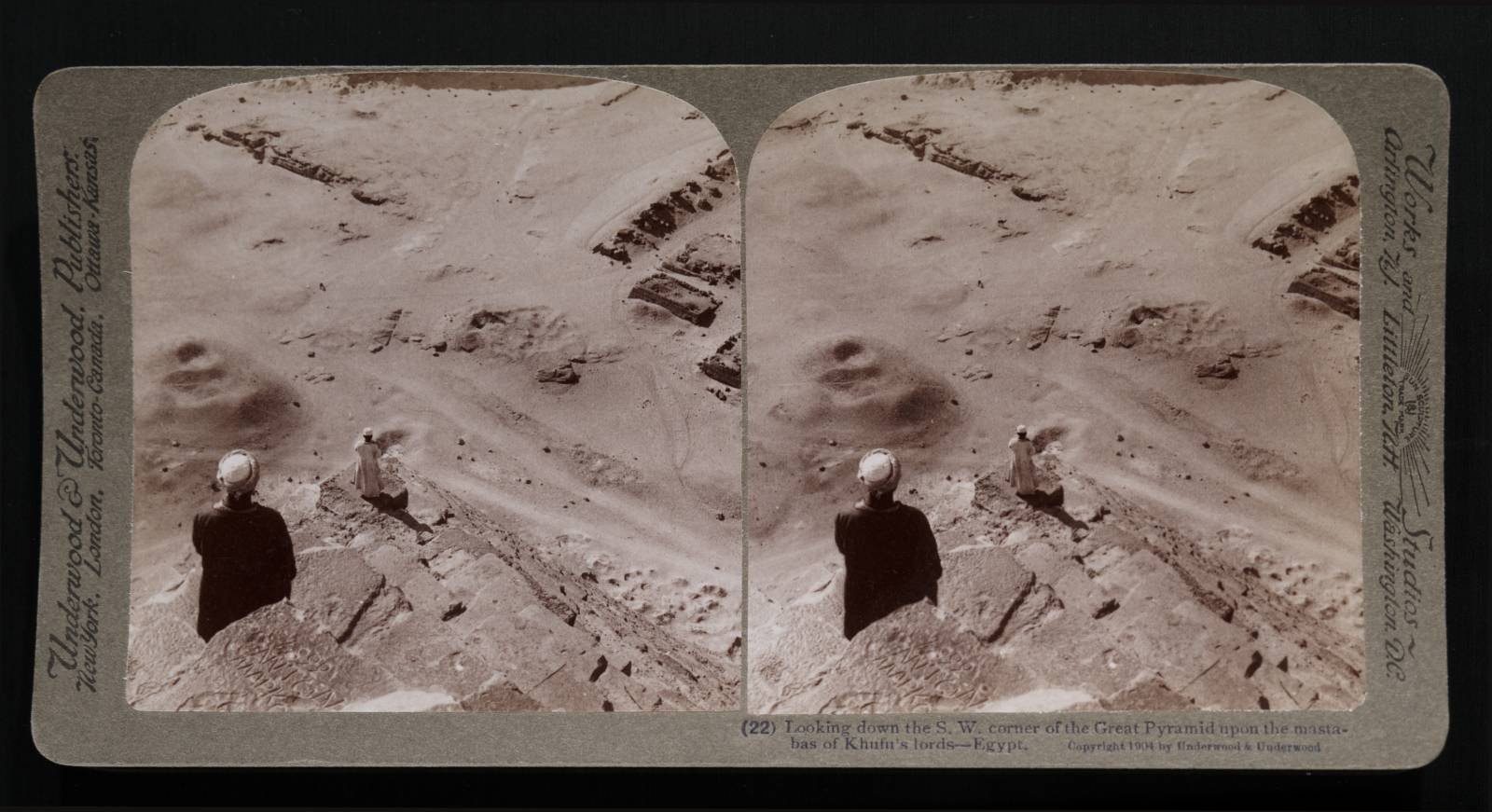Egypt Through The Stereoscope
A Journey Through The Land Of The Pharaohs
by James Henry Breasted | 1908 | 103,705 words
Examines how stereographs were used as a means of virtual travel. Focuses on James Henry Breasted's "Egypt through the Stereoscope" (1905, 1908). Provides context for resources in the Travelers in the Middle East Archive (TIMEA). Part 3 of a 4 part course called "History through the Stereoscope."...
Position 22 - Looking Down The Southwest Corner Of The Great Pyramid Upon The Mastabas Of Khufu's Lords
 We are now looking down the corner diagonally opposite the corner up which we looked before we ascended the pyramid. We are not here so impressed with the size of the pyramid as when we looked up, for the reason that the converging lines which in perspective produce the effect of distance, are here inverted as the great mass of the pyramid swells out beneath us. And yet if you will (lowering the instrument until you are looking toward the floor) let your eyes run down the precipitous sides nearly 500 feet to the desert below you will be ready to shrink back, I doubt not, at the suggestion of falling. One shudders at the thought of that white-robed native plunging from his dizzy height over the stone beneath. How insignificant that camel looks far down there on the sand.
We are now looking down the corner diagonally opposite the corner up which we looked before we ascended the pyramid. We are not here so impressed with the size of the pyramid as when we looked up, for the reason that the converging lines which in perspective produce the effect of distance, are here inverted as the great mass of the pyramid swells out beneath us. And yet if you will (lowering the instrument until you are looking toward the floor) let your eyes run down the precipitous sides nearly 500 feet to the desert below you will be ready to shrink back, I doubt not, at the suggestion of falling. One shudders at the thought of that white-robed native plunging from his dizzy height over the stone beneath. How insignificant that camel looks far down there on the sand.
However, we are looking down here chiefly to observe those mastabas on the right. Do you see how the central core of sand and rubble is held in place by the retaining wall of surrounding masonry? Does it occur to you that there was a time when that retaining wall was just a rude circle of unhewn boulders, gathered by primitive man around the sand-heap that marked the resting-place of his departed ancestor, to protect it from the drifting winds? Such it certainly once was, and you may see many a sand-heap on the margin of the desert here, marking the grave of the peasant of yesterday, with just a rude oval of hastily gathered stones about it, lest it should vanish in the drifting sands.
Now, as the mastaba has grown out of the sand-heap, so the pyramid has grown out of the mastaba, by placing one mastaba upon another and thus building a terraced pile diminishing as it rose, each mastaba being smaller than the one beneath it. Finally, in course of time, these terraced sides were filled out in one plane slope and thus at last the pyramid form was attained. When we go to Sakkara we shall see one of the terraced structures (Position 29), which form the transitional stage between the mastaba and the pyramid.
Since we first saw this pyramid we have once paused to think of all the long course of man's career that lies between us and its builders—but have we stopped to think of the long and marvelous development that lies behind the era of the pyramids? Remote as is this hoary monument, we may look behind it, down a still remoter vista of man's past development: at its hither end is the pyramid upon which we stand, then the massive mastaba down there, out of which the pyramid grew; and yet back of this, in the dim ages of the forgotten world, is the sand-heap grave. Here, the pyramid, the most tremendous feat of engineering achieved by ancient man; and yonder as its lineal ancestor, the lowly sand-heap that covers the body of the peasant plowman. This is evolution as the archaeologist sees it—not merely the law of the development of physiological forms, but also of human arts and human institutions.
For what an evolution is here! Not alone in the mechanical arts, which, beginning with the sand-heap, have finally achieved the pyramid; but also in the organization of society and of government, which, developing in the thousand years that lie between the sand-heap and the pyramid, have gradually passed from the feeble initiative of the individual to that of a highly organized state, so efficient that it is able to concentrate all its vast resources of wealth, of labor and of skill upon one supreme achievement, never later to be surpassed. Thus a whole stage of human progress lies behind this pyramid, and is to be traced in the monuments which are visible from its summit.
But we shall not have learned all that this monument has to tell us, till we have entered it, and we must now descend for that purpose. The entrance to which we now go was seen, you remember, in the north side from our Position 18. The standpoint we are about to take before that entrance is given on Map 5 by the red lines numbered 23.
